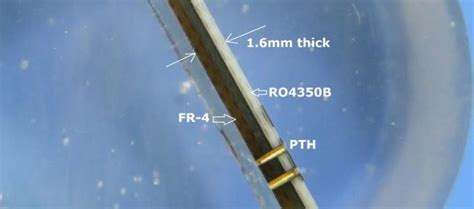RO4350B: A High-Frequency Laminate Material
RO4350B is a hydrocarbon ceramic laminate material developed by Rogers Corporation. It is designed to offer excellent electrical properties, making it suitable for high-frequency applications. Some key features of RO4350B include:
- Low dielectric constant (Dk) of 3.48 at 10 GHz
- Low dissipation factor (Df) of 0.0037 at 10 GHz
- Stable electrical properties over a wide frequency range
- Good thermal conductivity and low thermal expansion
- Excellent mechanical stability and low moisture absorption
Composition and Structure of RO4350B
RO4350B is composed of a ceramic-filled hydrocarbon matrix, which contributes to its unique electrical and mechanical properties. The material is reinforced with glass fibers to enhance its mechanical strength and dimensional stability.
The laminate structure of RO4350B typically consists of:
- Copper foil: The conductive layer used for creating circuit patterns
- RO4350B substrate: The dielectric material that provides insulation and supports the copper foil
- Adhesive: A bonding agent that holds the copper foil and substrate together
Frequency Characteristics of RO4350B
Dielectric Constant (Dk)
The dielectric constant (Dk) is a measure of a material’s ability to store electrical energy in an electric field. A lower Dk value indicates that the material has a lower capacitance, which is desirable for high-frequency applications. RO4350B has a Dk value of 3.48 at 10 GHz, making it suitable for High-Frequency PCB Designs.
Dissipation Factor (Df)
The dissipation factor (Df), also known as the loss tangent (tan δ), is a measure of a material’s power loss due to dielectric heating. A lower Df value indicates that the material has lower power loss and is more efficient in high-frequency applications. RO4350B has a Df value of 0.0037 at 10 GHz, which is considered excellent for high-frequency PCBs.
Frequency Range
RO4350B maintains stable electrical properties over a wide frequency range, from 1 GHz to 77 GHz. This makes it suitable for various high-frequency applications, such as:
- 5G wireless communication systems
- Millimeter-wave radar systems
- Satellite communication systems
- High-speed digital circuits
Designing with RO4350B
When designing PCBs using RO4350B, engineers must consider several factors to ensure optimal performance at high frequencies.
Controlled Impedance
Controlled impedance is essential for maintaining signal integrity in high-frequency PCB designs. RO4350B’s stable Dk value allows for accurate impedance control, minimizing signal reflections and distortions.
To achieve controlled impedance, designers must consider factors such as:
- Trace width and thickness
- Dielectric thickness
- Copper foil thickness
- Ground plane spacing
Microstrip and Stripline Configurations
RO4350B is compatible with both microstrip and stripline PCB configurations. The choice between these configurations depends on the specific design requirements, such as:
- Frequency range
- Signal integrity
- EMI/EMC considerations
- Board size and layer count
Microstrip configurations are generally easier to manufacture and offer better heat dissipation, while stripline configurations provide better signal isolation and reduced EMI.
Via Design
Proper via design is crucial for maintaining signal integrity in high-frequency PCBs. When designing vias for RO4350B, engineers should consider:
- Via diameter and pad size
- Via hole plating thickness
- Via stub length
- Ground via placement
Optimizing via design helps minimize signal reflections, crosstalk, and radiation losses.

RO4350B vs. Other High-Frequency Laminates
RO4350B is one of several high-frequency laminate materials available in the market. Some other popular options include:
- Rogers RO4003C: Dk = 3.55, Df = 0.0027 at 10 GHz
- Isola I-Tera MT40: Dk = 3.45, Df = 0.0031 at 10 GHz
- Taconic RF-35: Dk = 3.50, Df = 0.0033 at 10 GHz
The choice of laminate material depends on various factors, such as:
- Frequency range
- Electrical performance requirements
- Mechanical and thermal properties
- Cost and availability
Engineers should carefully evaluate the specific requirements of their project and select the most suitable laminate material accordingly.
Conclusion
RO4350B is a high-performance laminate material that offers excellent electrical properties for high-frequency PCB designs. With a low dielectric constant and dissipation factor, RO4350B maintains stable performance over a wide frequency range, making it suitable for various applications, such as 5G wireless communication, radar systems, and satellite communication.
When designing with RO4350B, engineers must consider factors such as controlled impedance, PCB configuration, and via design to ensure optimal performance at high frequencies. By understanding the frequency characteristics and design considerations of RO4350B, engineers can create high-quality PCBs that meet the demanding requirements of modern high-frequency electronics.
FAQ
- What is the dielectric constant (Dk) of RO4350B at 10 GHz?
-
The dielectric constant (Dk) of RO4350B at 10 GHz is 3.48.
-
What is the dissipation factor (Df) of RO4350B at 10 GHz?
-
The dissipation factor (Df) of RO4350B at 10 GHz is 0.0037.
-
What is the frequency range over which RO4350B maintains stable electrical properties?
-
RO4350B maintains stable electrical properties over a frequency range of 1 GHz to 77 GHz.
-
What are some applications where RO4350B is commonly used?
-
RO4350B is commonly used in applications such as 5G wireless communication systems, millimeter-wave radar systems, satellite communication systems, and high-speed digital circuits.
-
What are some other high-frequency laminate materials similar to RO4350B?
- Some other high-frequency laminate materials similar to RO4350B include Rogers RO4003C, Isola I-Tera MT40, and Taconic RF-35.
| Parameter | Value |
|---|---|
| Dielectric Constant (Dk) | 3.48 |
| Dissipation Factor (Df) | 0.0037 |
| Frequency Range | 1-77 GHz |

No responses yet